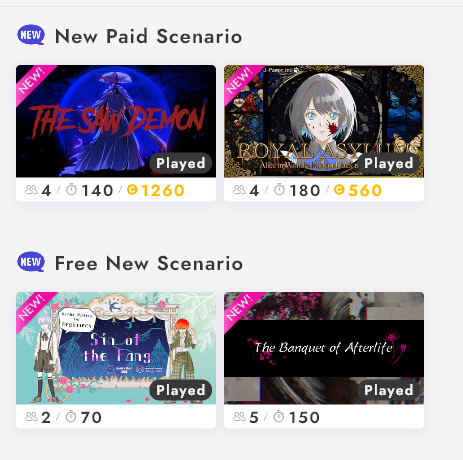Featured mechanic - Dynamic Investigation Scenes
- Mister RI
- Jan 12
- 3 min read
I've recently encountered an interesting design, which made the investigation scene felt "alive" and I wanted to share how they achieved it.
The overwhelming norm for a murder mystery is to have additional information available to the players as part of their investigation process.
There are many ways of investigating, but today I want to focus on the information itself.
Usually the investigation results are abstracted in the form of cards.
The table will have a spread of locations and a certain amount of cards will be available for each location/points of interest.
Whoever chooses to investigate that location will gain a corresponding card. First come first serve, does not matter who investigates where or when.
This is what this game does differently.
Upon set up, instead of a common pool of investigation cards,
This game subverts this norm by providing each player has their own set of cards for each points on interest!

What are the implications of this?
Personalized Narratives:
Each NPC will react to differently each player - their expressions are different, the information's they provide is personalized.
Diverse Perspectives: At the same location, the characters may obtain different information - because the things that the character focuses on and notices are different.
eg. Going to the study, a journalist may note the bookshelf and magazine, while the architect may notices peculiarities regarding the layout or the furniture.
Semi-Guided Exploration: This allows the designer to personalize the information that each players receives, allowing the clues to reference their personal backgrounds more explicitly, at the same time they might subtly guide the players to certain lines of thought. Allowing slightly more control on the player experience

There's more!
Dynamic Environments:
The most innovative aspect of this mechanic lies in its dynamic environments. Each location features a stack of multiple cards, and players can only access the top card.
The genius design is that the locations has multiple potential states, making player choices truly impactful.
It is easier to explain with an example:
Player A investigates the Journalist's room, he finds the Journalist's laptop of research materials regarding his personal secret.
He can choose to:
Leave it as it is.
Delete the materials.
If Player A chooses to leave it as it is, when Player B visits the same room, she will see the research materials.
If Player A chooses to delete the materials, the top card of Player B's "Journalist's Room" is discarded. If Player B investigates the "Journalist's Room" she will note that the materials are corrupted and barely readable.
Amazing! This is the first time I have experienced a dynamic and reactive scene in this manner. And we were blown away once we realized what was happening during the game.
There are even more fun stuff that goes into spoiler territory, but this approach really got my gears turning!
I hope you enjoyed this little titbit!
If this excites you, here's 4 ways I can help you!
Join our discord server or sign up for email newsletter to get news and new game releases~
Play Malice of Fantasy: A free GM less Jubensha that you can play with your friends online!
Play Malice of Starry Skies: Experience the first official English Jubensha online; the craze that has gripped Asia in recent years.
Buy me a Ko-fi to help me bring you better content, faster!

![[Beast of the Black Forest] A Chilling English Jubensha Experience](https://static.wixstatic.com/media/b3a0ad_8b74248f727c4369994331dff965ed24~mv2.png/v1/fill/w_980,h_1371,al_c,q_90,usm_0.66_1.00_0.01,enc_avif,quality_auto/b3a0ad_8b74248f727c4369994331dff965ed24~mv2.png)
Comments